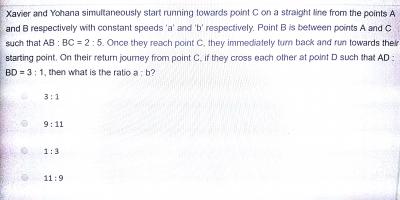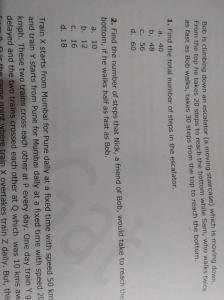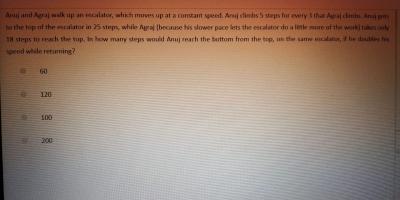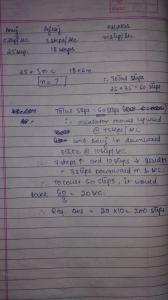Hello Samyak ,
A __2x__ B ______5x_____C
A __2y__ B __y__D________C
2y = 2x => x = y
Now , DC = 4x
Distance traveled by Xavier => AC + CD = 11x
Distance traveled by Yohana => BC + CD = 5x + 4x = 9x
Time taken by Xavier and Yohana is same here Hence ratio of speeds = Ratio of distance travelled
i.e 11x :9x = 11 : 9
A certain distance when is travelled at 3km/hr more than the usual speed ,the time taken to cover the distance would have been reduced by 2 hours than the usual time.Also,if the same distance is travelled at 4km/hr less than the usual speed,the time taken would have been increased by 5 hours more than the usual time.What is the distance?
A certain distance when is travelled at 3km/hr more than the usual speed ,the time taken to cover the distance would have been reduced by 2 hours than the usual time.Also,if the same distance is travelled at 4km/hr less than the usual speed,the time taken would have been increased by 5 hours more than the usual time.What is the distance?
Let the original speed be V km/hr an original time taken => T hr .
Now, VT = ( V +3) ( T -2)
=> VT = VT - 2V + 3T - 6 = VT
3T - 2V = 6..... (1)
also , VT = ( V - 4) ( T +5)
VT + 5V - 4T - 20 = VT
-4T + 5V = 20 .... ( 2)
From equation (1) and (2) V = 12 , T = 10
Distance traveled : 12 × 10 = 120 km .
1.
Let the escalator have a total of n steps and let it have moved through m steps by the time Bob took 20 steps.
therefore since Sam runs twice as fast as Bob, the time Sam takes 30 steps is equal to time in which Bob takes 15 steps .
The escalator moved m x 15/20 = 3m/4 steps .
So m + 20 = n and 3m/4 + 30 = n
m/4 = 10
m = 40 steps , n = 60 steps.
If Nick walk half as fast as Bob then let him take t times the time Bob takes => escalator would move through 40t steps and he would take 20t/2 steps
40t + 10t = 60
t = 1.2 times
So Nick would take 12 steps.
A thief is spotted by a policemen from a distance of 100 metres . When the policeman starts the chase , the thief also starts running . If the speed of the thief be 8 km/hr , how far the thief will have run before he is overtaken ?
Hi Richa,
The question seems to be incomplete... the speed of the policemen is not known.
Keshav goes one third distance upstream while going from point A to point B in a river in one hour, and then he drops his cloth in the river which travels now at the speed of the stream. While Keshav continues his journey towards point B and turns back immediately twards point A, and to his surprise he reaches point A at the same time when the cloth reaches there. Find the ratio of speed of stream to the speed of Keshav in still water.
Let total distance be 3x and Keshav removes his cloth after x distance
Now we have this equation for remaining journey
Also, let v be Keshav's and a be speed of stream then
2x/(v-a) + 3x/(v+a)= x/a
It means he goes 2x upstream with v-a speed and returns 3x downstream with v+a speed and in the same time clothes travel with the speed of stream i.e a
Solving this equation
(2v+2a +3v-3a)*a= (v^2 - a^2)
5va - a^2= v^2 - a^2
5a=v
a/v =5
Hence required ratio is 5:1
Sorry for the last line it will be a/v=1/5
So the ratio will be 1:5
A cyclist travels on a road parallel to railway track at a constant speed of 10 km/hour. He meets the train daily, at crossing, which also travelled in same direction as of him. One day, he was late by half an hour and meets the train 6 km before crossing. Find the speed of train.
Let x be time taken by the cyclist while traveling from his home to crossing
Earlier boy travels 10x distance, in same time train travels vx (assume speed of train be v)
Now boy travels 10(x+1/2)-6 and train travels vx-6 distance in same time
Ratio of velocity would be same in both cases so
10x/vx = {10(x+1/2)-6}/(vx-6)
Solving this we will get v =60
Alternative approach
The boy is 6km away because he was late for 1/2 hour in which he would have covered 10/2= 5 km so he would have been 1 km away at the same instant when train would have been 6 km away so in same time boy would cover next 1 km and train would cover 6 km to meet at the crossing so ratio of speed of boy to train =1x:6x
1x=10km/h
6x= 60km/h answer
|____d_____|______________2d___________|
d/2v + 2d/v = 20
5d/2v = 20
d/v = 8.
|____d_____|______________2d___________|
d/v + 2d/2v = T
T = 2d/v = 2 x 8 = 16.
Aniket, 16/3 is not possible
as 20/(16/3) = 3.xyz
means his average speed is more than thrice while coming back which is not possible
sir, the question is saying twice the length of time but you've taken twice the length of distance
it's asking for total time in return journey I didn't read it clearly. I got it now
let distance be 'd' and speed of train be x and boy be y
d/(x+y)=20
d/(x-y)=30
x/d+y/d=1/20
x/d-y/d=1/30
adding both we get 2x/d=1/12
d/x=24 which is the time taken for train to cover distance bw two stations
hence 24 is the answer
Alternative Approach :
speed of a train => x
and the boy's speed => y.
Now when the train goes in the same direction as the boy relative speed is x-y similarly it is x+y for opposite direction.
Now imagine the boy stops moving, relative speed of the train to the boy would just be x right ?
Hence, x-y, x and x+y form an AP. ( and distance is constant) time taken should form a HP.
Hence (2 x 20 x 30)/(20+30) = 24 minutes .
Ram, Shyam and Ghanshyam start running towards a circular track from same place and at same time in same directions but with different speeds. Ram and Shyam meet after every 2 minutes while Shyam and Ghanshyam meet every 3 minutes. If Ram and Ghanshyam meet after every ‘t’ minutes, then which of the following cannot be value of ‘t’?
1.2
4.8
Hi Utkarsh,
I can suggest you this
We don't know whose speed is greatest so we have to assume cases
Let speed be R ,G,S
Case 1 - R>G>S
R-S= D/2 { let circle be of distance D and we find relative speed of RAM w.r.t to shyam by assuming shyam to be still }
G-S =D/3
subtracting both
R-G= D/2-D/3= D/6
so the time t is 6 in this case which is in option
Case 2- G>S>R
S-R =D/2
G-S= D/3
adding both
G-R = 5D/6
t= 6/5= 1.2
So this is also possible hence option 4.8 is the answer
Note-If you will take other cases either you will get time negative or you will get same values as you got in these cases
Three friends A, B and C decide to run around a circular track. They start at the same time and run in the same direction. A is the quickest and when A finishes a lap, it is seen that C is as much behind B as B is behind A. When A completes 3 laps, C is the exact same position on the circular track as B was when A finished 1 lap. Find the ratio of the speeds of A, B and C?
5:4:2
4:3:2
5:4:3
3:2:1
Hi rachit
Let total length of circular track is d
And B is x away from end of the circular track so C is 2x away from end of the track
Let's compare ratio of speed of A and C
In first case A covers d distance and C covers d-2x and in second case A covers 3 lap means 3d distance and C covers 1 whole lap and comes to the position of B in same time so distance traveled is d+ d-x
d/3d= (d-2x)/(d+d-x)
Solving this we get x=d/5
Let d be 5 so x= 1
In first lap distanced traveled in same time by A ,B ,C are d , d-x d-2x putting values we get ratio as 5:4:3
smjhe to ni na.







